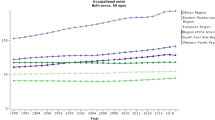Summary
The relationship between subjective work noise exposure and the risk of myocardial infarction (MI) was assessed in a population based casecontrol study. 395 MI patients (31–65 years) were compared to 2148 controls from a random population sample with the same age/sex distribution. The relative risk (RR) for MI—adjusted for control variables (smoking, age, social status, etc.)—was found to increase significantly and steadily with noise category. Subjective work noise exposure was the second greatest risk factor for MI after smoking. Possible bias due to overreporting of subjective noise exposure is discussed. Interdisciplinary studies on the relationship between cardiovascular diseases and workrelated stressors including subjective and objective noise assessment are needed to quantify the risk of MI due to work noise.
Zusammenfassung
In einer bevölkerungsbezogenen Fall-Kontroll-Studie wurde der Zusammenhang zwischen der subjektiven Arbeitslärmbelastung und dem Herzinfarktrisiko untersucht. 395 Herzinfarktpatienten im Alter von 31 bis 65 Jahren wurden mit 2148 Kontrollpersonen aus einer Zufallsstichprobe mit gleicher Alters- und Geschlechtsverteilung verglichen. Das relative Risiko für Herzinfarkt—adjustiert bezüglich mehrerer Einflussvariablen wie Rauchen, Alter, Sozialstatus usw.—stieg signifikant und monoton mit der Arbeitslärmbelastung an. Die subjektive Arbeitslärmbelastung erwies sich als der zweitwichtigste Risikofaktor für Herzinfarkt nach dem Rauchen. Mögliche Fehler wie z.B. Überbewertung der subjektiven Lärmbelastung werden diskutiert. Interdisziplinäre Studien zum Zusammenhang zwischen kardiovaskulären Erkrankungen und arbeitsplatzbezogenen Stressoren mit Erfassung der subjektiven und der objektiven Lärmbelastung sind notwendig, um das Herzinfarktrisiko durch Arbeitslärm zu quantifizieren.
Résumé
Le rapport entre la perception subjective de bruit gênant et le risque d'infarctus du myocarde (IM) fait l'objet d'une étude comparative portant sur 395 malades (IM) âgés de 31 à 65 ans et 2148 cas témoins sortis d'un sondage aléatoire parmi la population générale tout en assurant la même distribution d'âge et de sexe. II s'avère que—après la rectification exigée par les variables telles que consommation de tabac, âge, couche sociale, etc.—le risque relatif (RR) de IM augmente de manière significative et constante avec le gêne causé par le bruit au lieu de travail. Pour le IM, la perception subjective du bruit vécu au lieu de travail est le deuxième facteur de risque, son importance n'étant dépassée que par le tabagisme. Les auteurs discutent l'incidence possible d'une notification exagérée de bruit gênant. Afin de calculer le risque d' IM attributable au bruit perçu au lieu de travail, des études interdisciplinaires devraient être réalisées pour examiner les liens entre les maladies cardiovasculaires et les stresseurs liés au travail, y compris l'évaluation subjective et objective du bruit.
Similar content being viewed by others
References
Kristensen TS. Cardiovascular disease and the work environment. A critical review of the epidemiologic literature on non-chemical factors. Scand J Work Environ Health 1989;15:165–179.
Selye H. The stress of life. New York: McGraw-Hill, 1956.
Levi, L. Emotional stress. Basel: Karger, 1967.
Poppei M, Hecht K. Stressorenwirkung und chronischer Stress in Abhängigkeit von Zuständen des Organismus und von Umweltkonstellationen. Wiss Z Humboldt-Universität 1980;2:667.
Lazarus RS. Psychological stress and the coping process: New York: McGraw-Hill, 1966.
Wolf S. A formulation of psychosomatic mechanism. Proc. Third World Congress of Psychiatry. Montreal: Univ Toronto Press, 1963.
Guski R. Psychische Auswirkungen von Umweltlärm. Aktuelle Fragen. Bundesgesundheitsblatt 38, 1995;3:89–94.
Idzior-Walus, B. Coronary risk factors in men occupationally exposed to vibration and noise. Eur Heart J 1987;8:1040.
Ising H, Günther T, havestadt C. Blutdrucksteigerung durch Lärm am Arbeitsplatz. Bremerhaven: Wirtschaftsverlag, 1980.
Ising H, Rebentisch E. comparison of acute reactions and long-term extra-aural effects of occcupational and environmental noise exposure. In: Vallet M, ed. Noise and Man '93. Vol 3, 280. Inrets, Arcueil Cedex, 1993.
Babisch W, Ising H, Gallacher J, Sharp D, Baker I. Traffic noise and cardiovascular risk. The Caerphilly and Speedwell studies, second phase. Risk estimation, prevalence, and incidence of ischemic heart disease. Archives Environ Health 1993;48:401.
Babisch W, Elwood P, Ising H. Road traffic noise and heart disease risk: Results of the epidemiological studies in Caerphilly, Speedwell and Berlin. In: Vallet M, ed. Noise and Man '93. Vol 3, 260. Inrets, Arcueil Cedex, 1993.
Melamed S. Noise exposure, environmental annoyance and serum lipid/lipoprotein levels in bluecollar workers. The Cordis study. First International Symposium on Work Environment and Cardiovascular Disease. Copenhagen, 1995.
Thompson S. Epidemiology feasibility study: Effects of noise on the cardiovascular system. University of South Carolina, 1981.
Thompson S. Extraaural health effects of chronic noise exposure in humans [review]. In: Ising, H, Kruppa B, eds. Noise and Disease. Stuttgart, New York: Gustav Fischer, 1993.
Thompson S. Summary of team 3: Non-auditory physiological effects. In: Vallet M, ed. Noise and Man '93. Vol 3, 288. Cedex: Inrets, Arcueil, 1993.
Babisch W, Ising H, Kruppa B, Wiens D. The incidence of myocardial infarction and its relation to road traffic noise. Environment International 1994;20:469.
Babisch W, Ising H, Kruppa B, Wiens D. Verkehrslärm und Herzinfarkt. Ergebnisse zweier Fall-Kontroll-Studien in Berlin. WaBoLu-Hefte 2/1992. Berlin. Institute for Water-, Soil- and Air Hygiene of the Federal Health Office, 1992.
Mann HB. Myokardinfarkt und Arbeitsbelastung. Dissertation, Göttingen, 1994.
Thériault GP, Trembley CG, Armstrong BG. Risk of ischemic heart disease among primary aluminium production workers. Am J Indust Med 1988;13:659–666.
Bellach B, Dortschy R, Müller D, Ziese T. Gesundheitliche Auswirkungen von Lärmbelastung—Methodische Betrachtungen zu den Ergebnissen dreier epidemiologischer Studien. Bundesgesundheitsbaltt 1995;3:84–89.
Author information
Authors and Affiliations
Rights and permissions
About this article
Cite this article
Ising, H., Babisch, W., Kruppa, B. et al. Subjective work noise: A major risk factor in myocardial infarction. Soz Präventivmed 42, 216–222 (1997). https://doi.org/10.1007/BF02298042
Issue Date:
DOI: https://doi.org/10.1007/BF02298042




